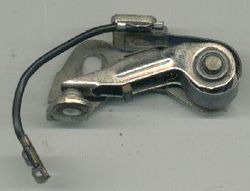- Contact breaker
-
A contact breaker (or "points") is a type of electrical switch, and the term typically refers to the switching device found in the distributor of the ignition systems of spark-ignition internal combustion engines.
Contents
Purpose
The purpose of the contact breaker is to interrupt the current flowing in the primary circuit of the ignition coil. When this occurs, the collapsing current induces a high voltage in the secondary winding of the coil, which has many more windings. This causes a very high voltage to appear at the coil output for a short period - enough to arc across the electrodes of a spark plug.
Operation
The contact breaker is operated by an engine-driven cam, and the position of the contact breaker is set so that they open (and hence generate a spark) at the exactly correct moment needed to ignite the fuel at the top of the piston's compression stroke. The contact breaker is usually mounted on a plate that is able to rotate relative to the camshaft operating it. The plate is rotated by a centrifugal mechanism, thus advancing the ignition timing (making the spark occur earlier) at higher revolutions. This gives the fuel time to burn so that the resulting gases reach their maximum pressure at the same time as the piston reaches the top of the cylinder. The plate's position can also be moved a small distance using a small manifold vacuum-operated servomechanism, providing advanced timing when the engine is required to speed up on demand. This helps to prevent pre-ignition (or pinging).
Disadvantages of contact breakers
Since they open and close several times every turn of the engine, contact breaker points and cam follower suffer from wear - both mechanical and pitting caused by arcing across the contacts. This latter effect is largely prevented by placing a capacitor parallel across the contact breaker - this is usually referred to by the more old fashioned term condenser by mechanics. As well as suppressing arcing, it helps boost the coil output by creating a resonant LC circuit with the coil windings.
A drawback of using a mechanical switch as part of the ignition timing is that it is not very precise, needs regular adjustment of the dwell (contact) angle, and at higher revolutions, its mass becomes significant, leading to poor operation at higher engine speeds. These effects can largely be overcome using electronic ignition systems, where the contact breakers are retrofitted by a magnetic (Hall effect) or optical sensor device. However, because of their simplicity, and since contact breaker points gradually degrade instead of catastrophically failing, they are still used on aircraft engines.
See also
Categories:- Automotive ignition systems
- Automotive electrics
Wikimedia Foundation. 2010.

